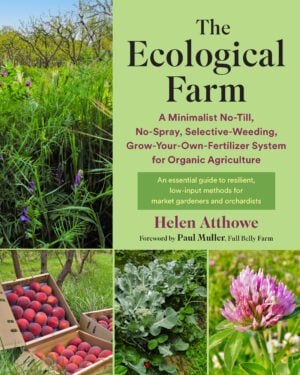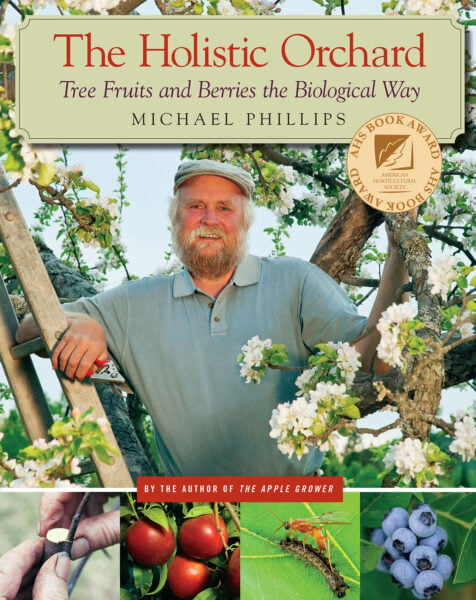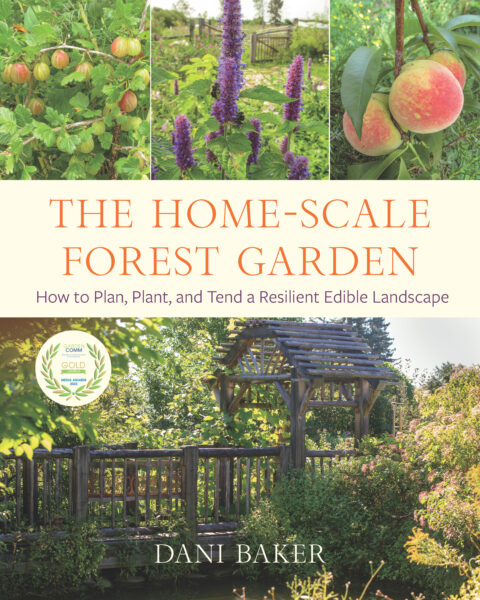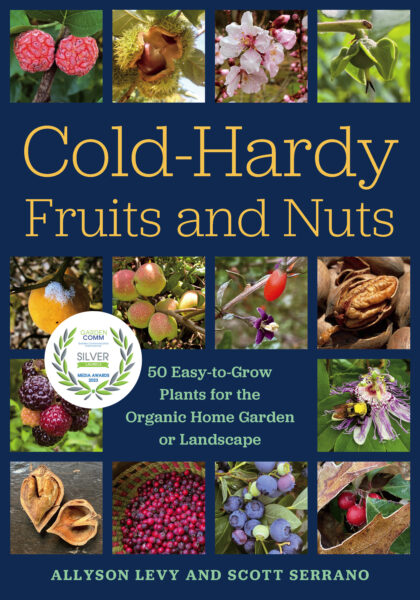How to Grow and Maintain Fruit Trees: General Fruit Tree Management
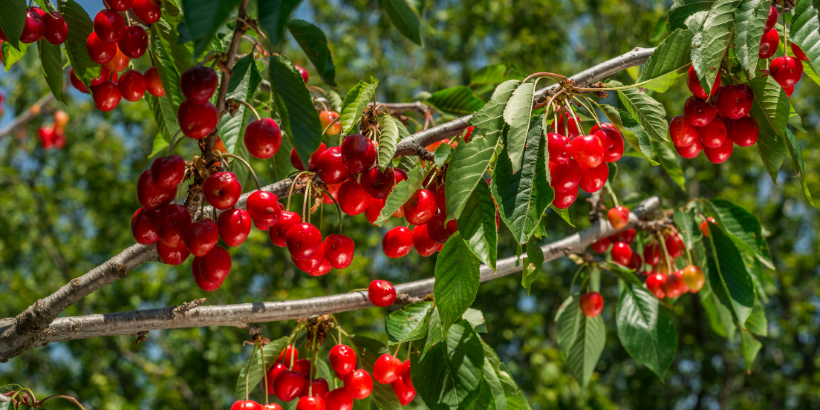
Thinking of growing fruit trees? While it’s no small undertaking, fruit trees are much more forgiving than annual crops once established. Fruits like apples, apricots, cherries, peaches, nectarines, pears, pluots, and plums can easily be grown on trees in your backyard — you just need to know the correct management practices before you get started.
The following is an excerpt from The Ecological Farm by Helen Atthowe. It has been adapted for the web.
Unless otherwise noted, all photographs copyright © 2023 by Helen Atthowe.
Fruit trees have specific environmental needs that help them to thrive and suppress pests. Managing these fiddly details may seem like a lot of mental work, but it helps to later avoid all of the extra inputs to manage diseases, insects, and fertility problems.
Deciding What to Grow
Consult with other growers, state universities, and local extension agents to learn what species and varieties of fruit trees do well in your area. Species and varieties that thrive in cold northern climates will be very different from those that thrive in hot southern climates.
As you plan where to locate plants, first do enough detective work so that you know what the basic preferences of your fruit trees are. Research the light, moisture, and soil preferences (see below) as well as the disease susceptibility (or resistance) for the trees and rootstocks you plan to grow. Match species, varieties, and rootstocks to the soil, sun, and shade microclimates in your garden or fields.
- Species that require full sun, such as cherry and plum trees, will not grow well in shady locations.
- Avoid planting species that are susceptible to foliar fungal diseases or bacterial canker diseases in lawn areas or near crops that are regularly irrigated. Regular watering of lawn grass or crops provides the higher humidity that many disease-causing microbes require to infect fruit trees.
- Avoid heavy, wet soils for plant species susceptible to root rot diseases.
Pollination
Most fruit trees need cross-pollination in order to produce fruit or to produce well. This means that two or more individual varieties with compatible pollen and similar bloom times must be planted near one another. Some fruit species are self-fruitful and do not require cross-pollination.
Sour cherry, most apricots, European-type plums (such as Stanley and Italian Prune), and peach/nectarine are self-fruitful. Apple, pear, sweet cherry, some apricots, and Japanese and American plums are not; they require companion pollinator trees of another compatible variety to produce good yields. Companion pollinator trees should be sited within 100 feet (30 m).
Insects make pollination happen for fruit trees. Honeybees and native bees do the majority of this pollination work, but a diversity of insects visiting fruit tree blossoms helps to transfer pollen throughout the orchard.
Rootstocks
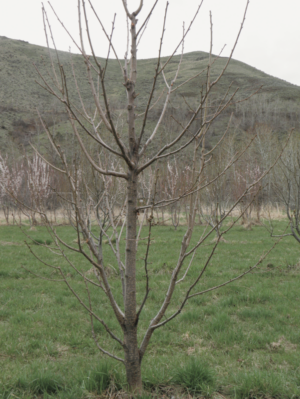
Figure 12.1. This cherry tree has naturally upright growth and is pruned to a central leader system.
For commercial production, most fruit tree varieties are grown as grafted plants. This means that the fruitful variety is “attached” to a rootstock variety through a process called budding. The rootstock variety imbues the trees with characteristics that the fruiting variety may not possess, such as size control, hardiness, and insect and disease resistance. Careful rootstock selection for your soils, climate, and conditions is another way to avoid potential pest and disease problems.
Apple Tree Rootstocks
Apple tree size as mediated by rootstocks is generally divided into three categories: standard (also called seedling), semi-dwarf, and dwarf. Standard trees are budded onto apple seedlings or standard-sized clonally produced rootstocks; they produce large trees that are 20 feet (6 m) tall or more.
The most common semi-dwarf apple rootstocks are M.7 or M.7a, M.26, and MM.106 or MM.111. M refers to rootstocks that were developed at the East Malling Research Station in England; MM rootstocks developed jointly at the East Malling and Merton stations. The MM series are not hardy in zones colder than USDA hardiness zone 4.
It is important to remember that shallow, low-fertility, and/or high-pH soils generally result in smaller-than-normal fruit trees, regardless of the rootstock. If your soil is not in great condition, it may not be a good idea to choose a dwarfing rootstock.
Pear Tree Rootstocks
For pear, some rootstocks are available for size control, but I recommend choosing fire-blight- resistant pear rootstocks as top priority! Many peach, plum, apricot, and cherry rootstocks are available, but long-term evaluations of these rootstock varieties are still ongoing.
Spacing
Appropriate spacing for fruit trees depends on the rootstock and the vigor of the variety. It also depends on your farming system. Trees on dwarfing and semi-dwarfing rootstocks can be planted more closely. Generally, it is best for tree health to plan on and provide more than adequate space per tree. If you plan to grow your own fertilizer within your orchard, as described in chapter 4, be sure to leave enough room between trees so that ground cover “fertilizer” and “habitat” plants can grow successfully.
When we began to grow our own fertilizer in our Oregon orchard, we increased the spacing both between trees in the row and also created wider row middles. We added 3 to 5 feet (0.9–1.5 m) to row middles and 1 to 3 feet (0.3–0.9 m) between trees in crop rows. We have plenty of land and space, so now I wish we had added even more space to our row middles. Tree health and fruit quality is generally better with more space.
Pruning
Shape fruit trees early in their lives to establish a central leader, a modified central leader, or an open center framework system. For a central leader system, the main trunk is encouraged to develop, and lateral branches called scaffolds extend out from the leader in three or four well-spaced layers. An open center system is a good choice for most stone fruit that want to grow naturally in a vase shape.
After heading back the central leader, allow three to five lateral scaffold branches between 2 to 3 feet (0.6–1.2 m) above ground level to develop. (See figure 12.2.) Another choice is a modified central leader system, which is a combination. The central leader is allowed to grow, and lateral branches are also encouraged to grow upright in a vase shape around the leader.
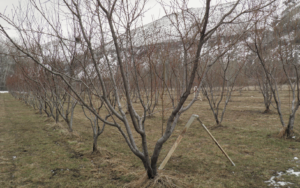
Figure 12.2. When this peach tree was young, its central leader was headed back to the top of a whorl of branches to stimulate an open center system. Growth now continues outward along the scaffolds each year.
These pruning system frameworks provide light to all parts of the tree and help to support the weight of fruit. Choose well-spaced main scaffolds that branch out at a 45-degree angle from the trunk to provide a strong skeleton for each tree. Then prune lightly annually to remove upright branches, diseased branches, or those too shaded by other branches, and encourage lateral branches to grow out away from the inner space of a tree.
Modified Pruning Systems
Apples and pears prefer a central leader or modified central leader pruning system. Stone fruit species do best with an open center or modified central leader pruning system. How much to prune depends on the species. Ranking in order from most to least vigorously pruned: apple, pear, peach, apricot, cherry, Japanese plum, pluot, and European plum.
Fertilization and Soil PH
Fruit trees generally require more nitrogen and phosphorus when they are young and developing their woody skeleton (1 to 8 years old). Fruit-bearing trees require less nitrogen and more potassium, calcium, and micronutrients (especially boron, iron, manganese, and zinc). Most fruit tree species covered in this book prefer a soil pH of 6.0 to 7.5. See the crop entries later in this chapter for more details on specific nutrient needs. In general, peaches and nectarines use the most nitrogen, followed by pears, while apples, apricots, and plums/pluots and cherries use the least amount of nitrogen per year.
Recommended Reads
The Six Pests Plaguing your Fruit Trees — and How to Control them Organically
How to Grow Healthy Plants: Strengthening Your Farm or Garden’s Immune System
Recent Articles
Garden strawberries are excellent for both covering the ground and for growing fruit. If you’re planning out a forest garden, or are just looking for a plant to use as ground cover, strawberries are a great option. The following is an excerpt from The Home-Scale Forest Garden by Dani Baker. It has been adapted for…
Read MoreAsparagus is a delicious vegetable with a layered history. How did this aspiring spear make its way from growing in the wild to appearing on our plates? The following is an excerpt from the The Seed Detective by Adam Alexander. It has been adapted for the web. “Nature gives us the key to every secret…
Read MoreInterested in growing trees? Here are some tips on successfully planting, transplanting, and pruning trees to create a flourishing forest garden! The following is an excerpt from The Home-Scale Forest Garden by Dani Baker. It has been adapted for the web. Planting Potted Trees and Shrubs If you order potted trees, check with your supplier to…
Read MoreWith the right strategies and practices, composting on a small farm is surprisingly easy and inexpensive. Just follow these steps for making compost, and your farm will be thriving in no time! The following excerpt is from The Lean Farm Guide to Growing Vegetables by Ben Hartman. It has been adapted for the web. (All photographs by Ben…
Read MoreGarlic mustard: while known as “invasive,” this plant can be consumed in its entirety and has great nutritional value. Plus, the garlic-flavor is a perfect addition to any recipe that calls for mustard! The following are excerpts from Beyond the War on Invasive Species by Tao Orion and The Wild Wisdom of Weeds by Katrina…
Read More

